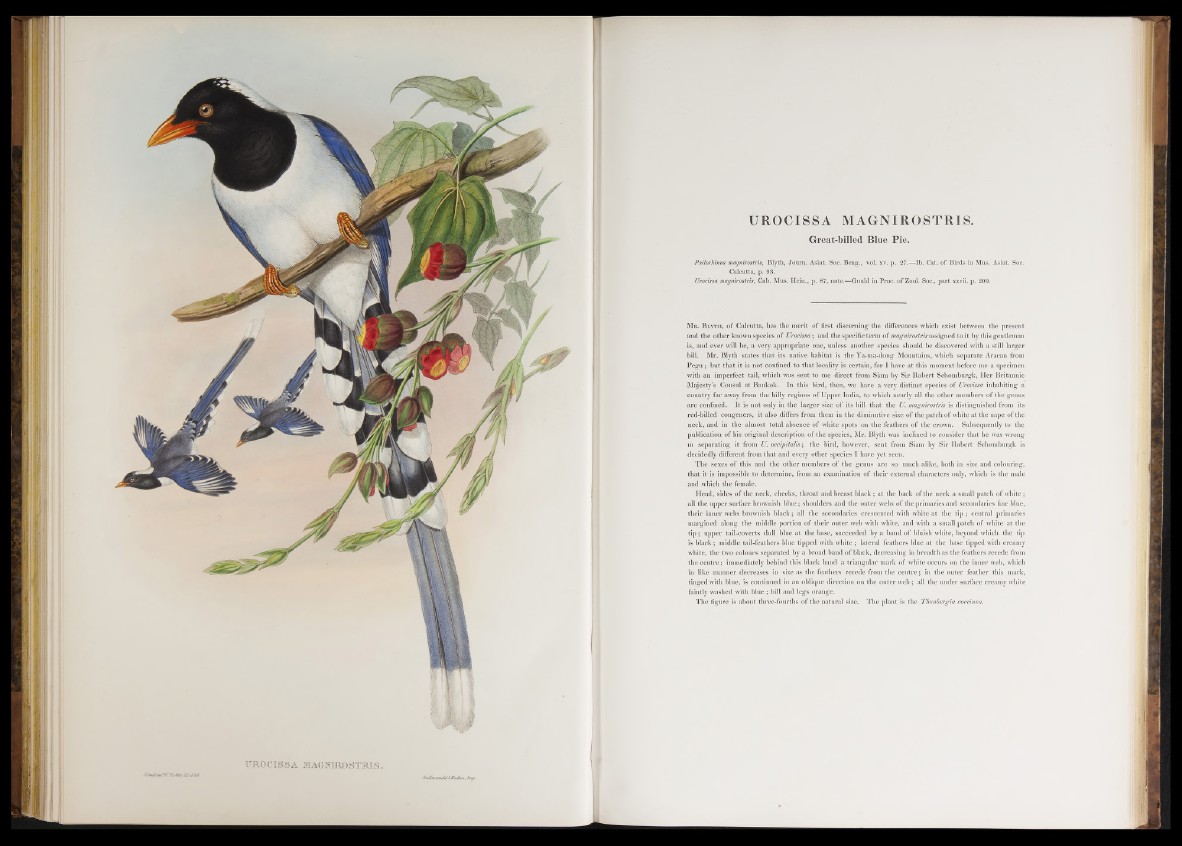
JGtm&lmdVC Kcihr ¿d lihü
UROCISSA MAGNIROSTRIS .
Great-billed Blue Pie.
Psilorhinus magnirostris, Blyth, Journ. Asiat. Soc. Beng., vol. xv. p. 27.—lb . Cat. o f Birds in Mus. Asiat. Soc.
Calcutta, p. 93.
Urocissa magnirostris, Cab. Mus. Hein., p . 87, note.—Gould in Proc. of Zool. Soc., p a r t xxvii. p. 200.
M r. B l y th , of Calcutta, has the merit of first discerning the differences which exist between the present
and the other known species of Urocissa; and the specific term of magnirostris assigned to it by this gentleman
is, and ever will be, a very appropriate one, unless another species should be discovered with a still larger
bill. Mr. Blyth states that its native habitat is the Ya-ma-dong Mountains, which separate Aracan from
P e g u ; but that it is not confined to that locality is certain, for I have at this moment before me a specimen
with an imperfect tail, which was sent to me direct from Siam by Sir Robert Schomburgk, Her Britannic
Majesty’s Consul a t Bankok. In this bird, then, we have a very distinct species of Urocissa inhabiting a
country far away from the hilly regions of Upper India, to which nearly all the other members of the genus
are confined. It is not only in the larger size of its bill that the U. magnirostris is distinguished from its
red-billed congeners, it also differs from them in the diminutive size of the patch o f white at the nape of the
neck, and in the almost total absence of white spots on the feathers o f the crown. Subsequently to the
publication of his original description of the species, Mr. Blyth was inclined to consider that he was wrong
in separating it from U. occipitalis; the bird, however, sent from Siam by Sir Robert Schomburgk is
decidedly different from that and every other species I have yet seen.
The sexes of this and the other members o f the genus are so much alike, both in size and colouring,
that it is impossible to determine, from an examination of their external characters only, which is the male
and which the female.
Head, sides o f the neck, cheeks, throat and breast black; a t the back of the neck a small patch of white;
all the upper surface brownish b lu e ; shoulders and the outer webs of the primaries and secondaries fine blue,
their inner webs brownish black; all the secondaries crescented with white at the tip ; central primaries
margined along the middle portion of their outer web with white, and with a small patch of white at the
t ip ; upper tail-coverts dull blue a t the base, succeeded by a band of bluish white, beyond which the tip
is black; middle tail-feathers blue tipped with white ; lateral feathers blue at the base tipped with creamy
white, the two colours separated by a broad band o f black, decreasing in breadth as the feathers recede from
the centre; immediately behind this black band a triangular mark of white occurs on the inner web, which
in like manner decreases in size as the feathers recede from the c en tre ; in the outer feather this mark,
tinged with blue, is continued in an oblique direction on the outer w eb; all the under surface creamy white
faintly washed with blue ; bill and legs orange.
The figure is about three-fourths of the natural size. The plant is the Tlunbergia coccinea.